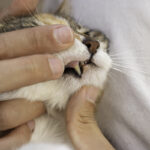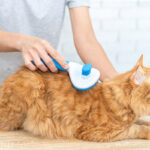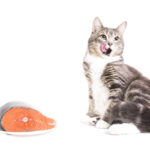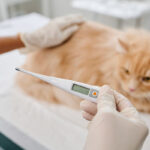Is your cat experiencing pain? Though your cat is suffering from some pain, it can be arduous to tell if your feline is in pain or not. For various reasons, pet owners may not be able to recognize if their pet is in pain. Until the cat shows obvious signs like lethargy and decreased appetite, you can’t notice the pain in cats.
Wondering ‘How to Tell If a Cat Is In Pain?’ Cats are highly popular for their ability to conceal pain and discomfort. Even if you are extremely close to the pet, your cat still tries hard to mask its intense pain.
If you understand the reason behind your cat’s pain, you will be able to treat it at home if the pain is due to some mild illness. If there is intense pain due to some chronic illness, you can take the cat to the vet for proper medical treatment. Learn the common Signs of Pain in Cats through this in-depth article.
Contents
- How to Tell If My Cat Is In Pain?
- Signs to Look For
- 1. Activity Level Changes
- 2. Increased Vocalization
- 3. Purring
- 4. Aggression
- 5. Poor Fur Condition
- 6. Unusual Postures
- 7. Low Appetite
- 8. Changes in Drinking Habits
- 9. Difficulty using the Litter Box
- 10. Changes in Behaviour
- 11. Changes in Grooming Habits
- 12. Enhanced Irritability
- 13. Concealing
- 14. Limping
- 15. Lethargy
- 16. Rapid or Difficulty in Breathing
- 17. Self-Mutilation
- 18. Gum Color Variations
- 19. Uninterested in Daily Routine
- 20. Struggling to Urinate
- 21. Increased Biting & Scratching
- 22. Evading Brightness
- 23. Changes in Sleep Schedule
- 24. Bizarre Facial Expressions
- 25. Drooling
- 26. Uninterested in Socializing
- Causes for Pain in Cats
- How Does My Cat Expresses It’s Pain?
- What to Do If My Cat Is In Pain?
- Conclusion
How to Tell If My Cat Is In Pain?
Felines have a wonderful skill to lessen their stress and heal their pain by purring. Also, cats are experts at masking their illness and pain. When a cat howls or cries out so much then, we can understand that the cat is in pain or severe discomfort.
But, if the cat is suffering from pain due to some long-term or chronic health condition, it may not show any signs. However, the good news is that cat owners can identify when their cat is in pain by looking at the common signs. It is highly important to notice the tell-tale signs of pain in cats.
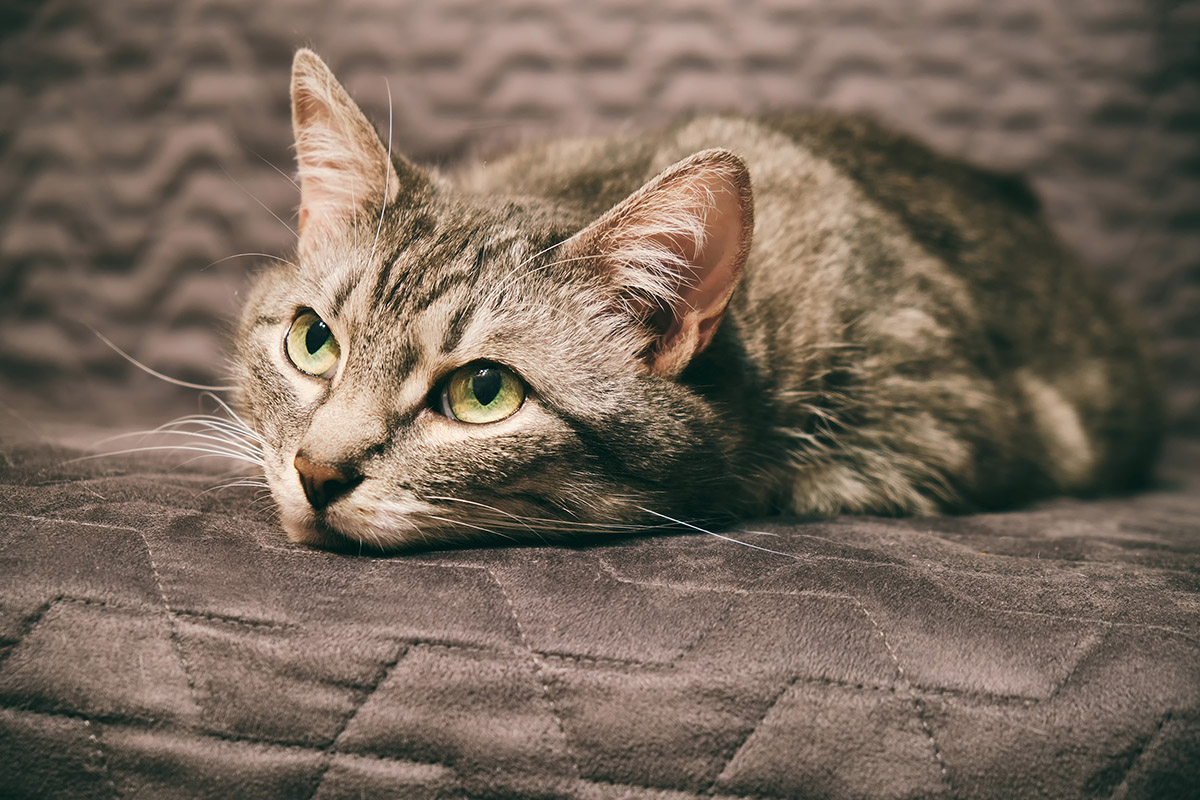
One of the reasons behind your cat hiding its pain is not to exhibit its signs of weakness. Usually, cats living in the wild around predators don’t want to display their signs of fragility considering it as an advantage.
But, when the cat is your pet, it would be a great difficulty for the pet parent if there is no clue to tell that the cat is in pain due to an illness or injury. By identifying the symptoms of cat in pain, you will be able to follow easy ways to treat its pain and provide adequate comfort before the condition worsens.
Signs to Look For
The International Veterinary Academy of Pain Management has given a checklist for the Signs of Pain in Cats that helps pet parents to check in their cats and take necessary action. This helps your vet to figure out the causes and treatments to be given to heal the pain in cats.
Whenever cats feel pain just like humans, it may have a major impact on their behavior of the cat. Few cats exhibit behavioral changes while some other cats display physical signs. The change in behavior and physical changes may include energy level, attitude, hunger and thirst, sleeping habits, way of walking, and more.
Even a mild sign of a cat in pain and a slight change in the behavior of the cat may indicate that the feline is ill or suffering from pain. As the feline can’t tell you that it is in pain, you must observe your cat’s unusual behavior patterns. Hence, the vet will depend on the pet parent to find out if there are any changes noticed in the cat’s behavior related to pain.
Let’s explore the common signs and symptoms of pain experienced by the cat.
1. Activity Level Changes
One of the major signs of a cat experiencing pain is the change in the activity level of the cat. When you witness a change in activity level, it indicates that the cat is feeling discomfort. Some of the changes include the cat sleeping more hours than usual and becoming inactive.
In case, the cat is suffering from arthritis, it may be unwilling to alter its positions or jump on high surfaces due to the joint pains. In some cats, we may witness pro-activeness like getting up and down continuously and striving hard to settle down comfortably.
2. Increased Vocalization
Due to intense pain, few cats turn more vocal compared to others. In general days, if your cat is a quiet one but suddenly starts crying, yowling, meowing, moaning, etc then, it indicates the cat is in pain. If you touch a specific spot on the cat’s body, it increases vocalization.
If your cat is growling and hissing excessively then, it means that the cat is unhappy. If in case, the cat is yowling in severe pain then, your cat needs immediate vet attention. If nothing seems to appear physically then, the pain could be something internal.
3. Purring
Purring is a common sign of happiness and contentment we can usually witness in cats. But, if your cat is purring out of terror or hurt then, it means your cat is in pain.
Sometimes, cats may purr to tell that they’re stressed and feeling anxious for some reason. When a cat is in pain or discomfort, the cat may start purring. If your feline’s purring has increased associated with other symptoms then, it is related to some intense pain in the cat.
4. Aggression
When the cat is in intense pain, it starts exhibiting its aggressive nature by hissing, growling, and sometimes biting. Another way the cat shows its aggression is by pinning their ears back. Abrupt aggression in cats is an indication of pain in cats.
For instance, if your feline has an injury on her hand, she tries to lash out at you when you try to touch her hand, it starts defending itself. In case, if you try to take your cat to the vet, it becomes even more aggressive and starts biting you. This sort of aggression is referred to as pain in cats.
5. Poor Fur Condition
Cats are extremely good at grooming. In general, felines spend almost five hours a day grooming to maintain their soft fur. When the cat is in pain, it may start grooming repetitively due to discomfort. Due to excessive grooming all day, the cat’s fur loses its smoothness. This will result in poor coat condition of the cat.
6. Unusual Postures
When a cat is in pain, we may not witness their routine postures. We can see a very protective posture when the cat is suffering from abdominal pain. In that situation, the cat doesn’t wish anyone touching that particular area of the body due to pain.
Cat in Pain will try to curl up itself completely like a ball and sit in a crouched posture. In this posture, the cat curves its back higher keeping its head lower and folded front paws. In this position, the cat may feel difficulty in scratching.
7. Low Appetite
Cats in pain will have a loss of appetite. If you have been observing your cat not eating well lately and this sort of behavior continues for more than two days then, it’s time to take the cat to the vet.
In case, you have recently made changes to its diet then, your cat may have a loss of appetite for this reason as well. Hence, it is important to find out the cause of appetite loss in your cat. If there is appetite loss associated with other signs then, it indicates pain in the cat.
8. Changes in Drinking Habits
If you observe any sort of changes in the cat’s drinking habits then, it could be an indication of an underlying cause. If your cat has reduced the intake of water alongside other signs then, it’s an indication of a serious medical problem in your cat.
9. Difficulty using the Litter Box
Due to severe pain, your cat may not be able to access the litter box. It could be difficult for your cat to climb and squat on the litter tray. If the cat is having knee pain or hip pain due to arthritis then, it will have difficulty squatting.
As a result, your cat may start pooping or peeing outside the litterbox. This sort of change in cats may appear to be a behavioral change in felines. Otherwise, your cat may be suffering from a serious condition like UTI or Arthritis.
10. Changes in Behaviour
When your cat has started changing its behavior, it indicates that cats is in pain. However, these changes could be subtle sometimes. For instance, a cat that used to roam around the home throughout the day remains silent and sits in one place without any movement.
If your cat has been showing diminished levels of energy lately, it’s another big sign of a behavioral change. Behavioral change is an early indicator of a Cat in Pain or some sickness. Pain can bring any sort of change in cats like scratching biting, hissing, aggressive, etc.
11. Changes in Grooming Habits
The pet parents may witness certain changes in the grooming habits of their feline companion. If the cat is highly interested in grooming quite often, it may stop grooming due to pain and vice versa.
Cats are very particular about hygiene and their cleaning habits. Hence, try to be aware of your feline’s grooming habits whether they have changed or not.
12. Enhanced Irritability
A cat in pain can show its aggression in a variety of ways. Sometimes, cats may exhibit increased irritability because of the intense pain. The cat may not feel comfortable being held in the hands of its favorite person in the house.
Sometimes, the cat may not like its owner cuddling it out of love and affection. Out of irritability, it may even bite or scratch its owner. Be careful about your cat’s painful area and try to understand its pain as early as possible.
13. Concealing
Is your cat very much mobilized? Despite being a socialized pet, but has started hiding itself from the family or the strangers who enter into the house, which could be an indication of pain and discomfort. Most pet owners express that they have witnessed this sort of change in their ill cats.
If your feline is extremely active, always moving along with you from the living area to the kitchen, bedroom, and other spots but now, it has stopped moving from its place, it could be a sign of pain.
14. Limping
Limping is another common sign of a cat in pain. You can observe which part of the cat’s body is causing the problem. If your cat is suffering a lot to place its paw on the floor then, it’s understandable there is an underlying health issue in the cat.
15. Lethargy
Lethargy is one of the major signs of a cat experiencing pain. Cats suffering from lethargy may spend more time lying in one place. Due to the pain, the cat may have lack of energy. If the cat’s joints and muscles are painful, it doesn’t let the cat move around.
16. Rapid or Difficulty in Breathing
If you find your cat is breathing fast or facing difficulty in breathing then, it may be because of pain in the cat. There will be a change in the stomach movements and chest muscle movements of the cat while breathing. If you find such a condition in the cat, try to check the respiratory rate of your cat.
Try to count the number of breaths your cat takes for 15 seconds while it is asleep and then multiply the number of breaths by 4. Count the total number of breaths per minute. You can either use a watch or phone to count the cat’s breaths. Usually, a cat’s respiratory rate ranges from 12 to 60 breaths per minute. if the breathing rate is abnormal then, it is a sign of pain in a cat.
17. Self-Mutilation
In general, cats will lick and bite their bodies, especially in the areas where there is pain. Felines do this quite often as it may cause secondary trauma to the body through skin infections, loss of hair, injuries, etc.
18. Gum Color Variations
In general, the color of a cat’s gum will be light pink or some other similar color. Try to observe the gum color of your cat slowly. If there is a change in the color of the gum like purple, blue, grey, white, and others, then, it indicates that there is oxygen deficiency in the tissues. If the gum color is bright red then, it may indicate enhanced blood pressure or pain in cats.
19. Uninterested in Daily Routine
The daily routine of the cat may be changed completely due to pain. The cats may have confusion about peeing or pooping in the litter box despite being habituated to it. Lack of energy in the cat to engage in routine activities like playing, chasing, jumping, etc., due to severe pain.
While standing still or in a resting position, the cat’s legs may tremble or shiver out of pain. Your cat may no longer stay active by climbing trees, jumping onto the couch, etc. When you notice any of these changes in the routine activities then, you must understand that the cat is in pain.
20. Struggling to Urinate
When your cat is striving hard to urinate then, it’s an indication that it is in pain. This pain could be related to UTIs or other urinary infections.
21. Increased Biting & Scratching
Due to severe pain, your cat may likely bite and scratch the person who holds it. Even if the cat is in the hands of its owner, it may bite them with its teeth and scratch using its claws.
This could be because the person may touch the cat’s body in a painful location. When the feline understands that the person is trying to touch the painful spot, it will involuntarily bite the person.
22. Evading Brightness
Avoiding bright areas is one of the behavioral signs of pain in cats. The cats avoid seeing bright lights due to pain. This could be because of pain in its eyes. When cats experience strained eyes, they may try to close its eyes or avoid moving in bright areas.
23. Changes in Sleep Schedule
The pet parents may notice changes in the sleeping habits of the cat due to pain. While some cats sleep more, some other felines may have difficulty sleeping. In some felines, we can witness the cat sleeping in an abnormal position and sleeping in unusual places in the house.
24. Bizarre Facial Expressions
We can understand that the cat is in pain through its facial expressions. However, it might be slightly difficult to measure the cat’s pain from its facial expression.
If the cat is staring at nothing or constantly putting a glazed expression on its face may indicate that the cat is in pain. When cats are in discomfort or stress, they make dilated pupils. If in case, your cat is panting all of a sudden especially while resting, you can assess your cat’s pain.
25. Drooling
Felines may start drooling when they are experiencing pain. Drooling may occur in cats for a myriad of reasons. Your cat may drool due to some dental problem, oral disease, tongue problems, nausea, pain in the abdomen, pancreatitis, and other problems.
26. Uninterested in Socializing
If your cat is a socio-active animal but trying to avoid being among humans or animals indicates pain in the cat. If your cat is trying to stay behind furniture or hide in the closet then, it may be because of its pain.
Causes for Pain in Cats
Before understanding the ways about How to Comfort a Cat in Pain, it is important to figure out the causes behind the pain. Till now, you’ve seen the Signs of Pain in Cats.
Now, let’s find out what causes pain in cats. There could be a myriad of reasons behind the cause of pain in cats. Some of the major causes of pain in felines have been compiled as a list below. Check it out!
- Dental Problems
- Urinary Tract Infections
- Cancer
- Infection
- Surgery
- Arthritis
- Digestive Issues
- Trauma
- Eye Problems
- Neurological Disorders
- Exposure to Increased hot or Cold temperatures
- Bladder Problems
- Inflammation
To treat the pain in cats for whatever reason, you can give Pain Meds for Cats as prescribed by the veterinarian. By following the vet’s suggestions, you can understand the cat’s pain and treat it accordingly.
How Does My Cat Expresses It’s Pain?
Well, in most situations cat doesn’t express its pain. However, in rare situations, cats may express their pain in a variety of ways. Here is a list of ways your cat may try to express its pain. Check it out!
- The cat may appear as if it is seeking to curl up like a ball.
- Felines try to change their facial expressions in different ways like squinting, flattening the ears, closing their eyes, and more. Sometimes, the cat’s nose, mouth, and cheeks appear to be tense when it is in pain.
- Few cats stay squeezed with their legs placed beneath themselves when lying down.
- The sitting position of the cat varies i.e., it raises its body forward by lowering the head and curving the back.
What to Do If My Cat Is In Pain?
If you have been observing various changes in your cat lately, you may be worried extremely as a pet parent. If you have noticed a variety of signs telling you that your cat is in pain then, you can do something instead of staying still.
If you are thinking about ‘What Can I Give My Cat for Pain’ then, you can seek veterinary care if the cat is experiencing severe pain. Whatever the reason could be behind the cause of pain in cats, never try to give pain medications or painkillers to reduce your cat’s suffering.
The medications that are designed for humans shouldn’t be given to cats or dogs. The way cats metabolize the medication is slightly different from other animals or species.
In worst situations, general medications [human-related] used to treat pain can cause death in cats. It is highly important to consult a veterinarian regarding the pain in cats. As per the prescribed medication given by the vet, you must follow the vet’s recommendations.
Considering the cause of pain in cats, the vet will start a pain relief therapy plan. Make sure you tell the entire health history and medical history of your cat to the veterinarian so that he can analyze the condition of the feline. Instead of ignoring your cat’s pain, try to give proper treatment from the vet.
Some of the pain treatment methodologies and therapies available to the cat include joint supplements, Natural Pain Relief for Cats, alternative treatment therapy, prescription pain medications, and more. Massaging and acupuncture are considered the natural therapy to treat pain in cats.
Apart from the medication, supportive care is also essential to make your cat feel comfortable even in pain. Supportive care includes making necessary environmental changes, providing nutritional supplements, administering IV fluids if required, and more.
Conclusion
That’s all! This is everything you need to know about the signs that help you understand ‘How to Tell if a cat is in pain’. Through this article, we have explained the major signs of pain in cats, the causes of pain in cats, medications to be given, and more. Stay in touch with our website TheCrazyCats for more articles related to cats, cat behavior, food habits, health issues, and more.


